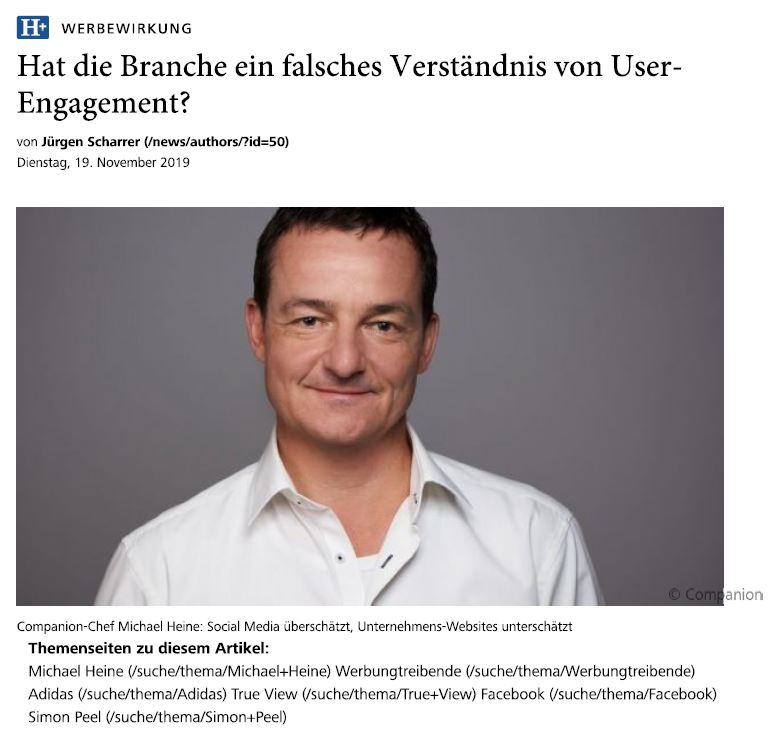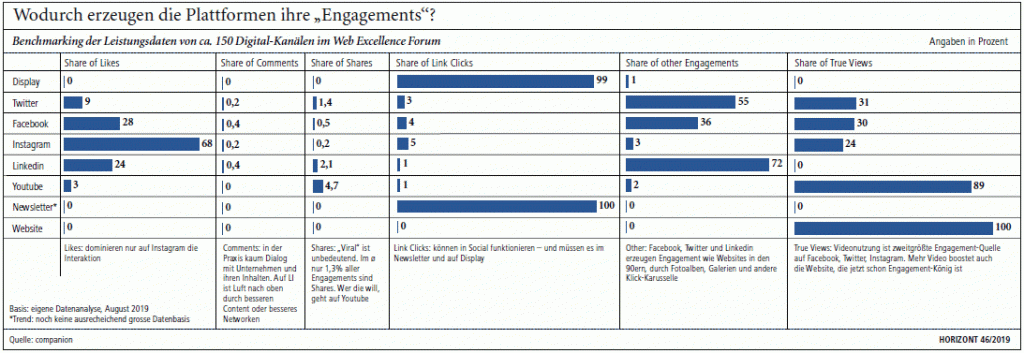Wir fragten uns: “Was steckt eigentlich hinter der Engagement-Rate? Und wie erzeugen eigentlich verschiedene Plattformen ihr Engagement?” Dazu schauten wir einmal in unsere Content.ONE Daten und erzeugten eine einfache Auswertung, den Vergleich aller Engagementformen quer über alle Plattformen. Unseren Blog-Beitrag zur Häufigkeit verschiedener Engagement-Typen gibt es hier. Zum selben Thema hier ein Artikel von Jürgen Scharrer in der aktuellen Horizont.
“Engagement”: was sagen Klicks aus über Rezeption und mögliche Werbewirkung?
Alle Werbungtreibende lechzen danach: Likes, Shares, Klicks und Kommentare. Doch was sagen diese Kennziffern wirklich aus über das Engagement der User? Michael Heine von Companion ruft der Branche eine alte Marketing-Gewissheit neu ins Gedächtnis: “Die wirkstärkste Form der Vermittlung von Inhalten ist die passive Mediennutzung ohne Interaktion: Man schaut einen Film und ist beeindruckt, ganz ohne Popcorn-Schmeißen oder Klickerei.”
Die Werbebranche hat ein neues Lieblingsthema: Nach einem Weckruf von Adidas-Mediadirektor Simon Peel wird heftig darüber debattiert, ob man es in den vergangenen Jahren nicht arg übertrieben hat mit einem auf kurzfristige Abverkaufserfolge abzielenden Performance Marketing. Viele Branchengrößen haben sich mittlerweile zu Wort gemeldet, und von den Einlassungen ließ vor allem die von Michael Heine aufhorchen, dem Chef des Beratungsunternehmens Companion. In seinem HORIZONT-Gastbeitrag “Schluss mit Data-driven Nonsense” finden sich Sätze von einiger Wucht. Zum Beispiel dieser: “Dass man mit Paid Search und Online Display keine Marke aufbauen kann, sollten alle wissen, die ihr Fachwissen nicht aus Google-Schulungen haben. Marke braucht Rezeption – was kann man tun, damit diese Binsenweisheit ins Allgemeinwissen der Digital Naiven einwandert?”
Jetzt sorgt Heine mit einer neuen Untersuchung für weiteren Gesprächsstoff. Darin geht es um einen Dauerbrenner des digitalen Marketings, das Engagement der User. Die herrschende Lehre: Je interaktiver eine Kommunikation, desto größer die Werbewirkung. Es lebe der dauerpartizipative Konsument!
Michael Heine setzt früh an, indem er erst einmal Grundsätzliches zum Thema User-Engagement sagt. Sein zentraler Satz: “Kommunikations-Profis wissen, dass die wirkstärkste Form der Vermittlung von Inhalten die passive Mediennutzung ohne Interaktion ist: Man schaut einen Film und ist beeindruckt, ganz ohne Popcorn-Schmeißen oder Klickerei.”
Eine solche Sicht der Dinge unterscheidet sich diametral von allem, wie User-Engagement im digitalen Marketing diskutiert wird. Hier herrscht eine reine klickbasierte Definition. Die einfache Logik: Je mehr Shares, Kommentare und Likes, desto erfolgreicher ein Post oder eine Kampagne.
Sehdauer ist auch “Engagement” – sogar das wichtigere
Hat Heine recht – und alle Studien sprechen dafür –, erzählen die gängigen Leistungskennziffern (KPIs) aber nur die Hälfte der Geschichte. Der Ansatz von Companion besteht konkret darin, die klickbasierte Betrachtung durch eine Viewtime-basierte zu ergänzen.
Companion zählt also einerseits die Interaktionen, genau so, wie sie von den Dashboards der Plattformen angeliefert werden. Zusätzlich werden aber auch die “True Views” von Video-Ads berücksichtigt. Die einfache Gleichung bei Companion lautet: eine Interaktion + ein True View = zwei Engagements.
„Kommunikations-Profis wissen, dass die wirkstärkste Form der Vermittlung von Inhalten die passive Mediennutzung ohne Interaktion ist: Man schaut einen Film und ist beeindruckt, ganz ohne Popcorn-Schmeißen oder Klickerei.“
Konkret haben sich Heine und seine Leute anhand von fünf Milliarden Impressions (Pages, Posts und Videos) angeschaut, wie sich die Engagements verteilen und wodurch sie erzeugt werden. Die Studie erhebt keinen Anspruch auf Repräsentativität – die Basis ist aber so breit, dass sich sehr wohl belastbare Aussagen davon ableiten lassen.
Welchen Erkenntnisgewinn bringen nun die Ergebnisse? Was zuerst ins Auge fällt, ist die extrem geringe Bedeutung von Kommentaren. Die tragen zu den gezählten Engagements zwischen 0 und 0,4 Prozent bei. Auch viral läuft in der Regel sehr wenig. Punkten können hier nur Youtube und Linkedin und mit Abstrichen Twitter Überhaupt sei die Aktivierung der User auf Social Media geringer als erwartet, schreiben die Autoren. Nur 2 bis 6 Prozent der User zeigen hier überhaupt eine Form des Engagements!
Website und Newsletter bekommen wieder Anerkennung
Deutlich besser fallen die Zahlen für Newsletter und Websites aus – hier erreichen die Interaktionsraten 18 beziehungsweise 16 Prozent. Das ist zum einen keine Überraschung, weil Owned-Media-Kanäle in der Regel vor allem von Menschen genutzt werden, die bereits ein gewisses Interesse mitbringen. Die Companion-Zahlen sind dennoch augenöffnend. Hebt man nämlich nur auf Likes und Shares ab, sind Unternehmens-Websites Facebook, Instagram und Co hoffnungslos unterlegen. Berücksichtigt man dagegen auch das Kriterium Viewtime, ergibt sich ein ganz anderes Bild. Das Fazit lautet: “Content trifft Zielgruppe. Newsletter und Websites engagen deutlich am besten.” Investitionen in eigene Kanäle sind demnach effektiver als gedacht.
Das Ganze ist mehr als nur eine interessante Zahlenspielerei. Stehen allein klickbasierte Werte im Zentrum, hat das konkrete Folgen für die Strategie. Dann geht es nämlich darum, die Klicks um jeden Preis zu erhöhen. Und das schafft man eben am besten, wenn man Klick-Karusselle in Gang setzt. Der User muss mit dem Inhalt interagieren, um ihn überhaupt zu kriegen. Diese “reinen Bedienvorgänge” würden als Engagement gezählt, seien es in Wahrheit aber oft gar nicht, so Heine.
Da schließt sich der Kreis zu dem, was der Companion-Chef zum “Fall Adidas” zu sagen hat. Im digitalen Marketing wird allzu häufig auf Kennziffern optimiert, die letztlich in die falsche Richtung führen. Heine: “Markenwert baut man nicht mit Klicks auf. Mit Sehdauer dagegen schon, dem passiven Engagement in Form innerer Beteiligung beim Zuschauen oder Lesen von Inhalten.

